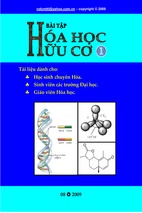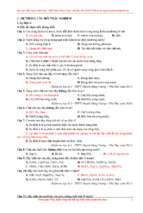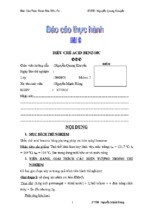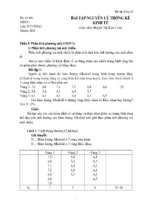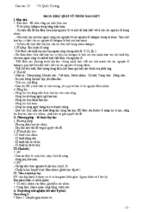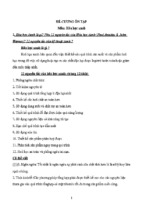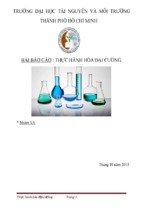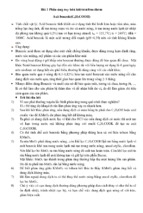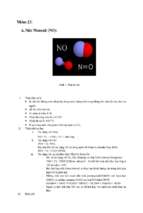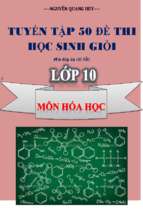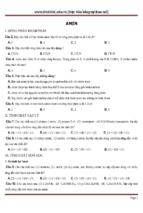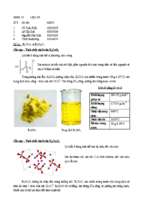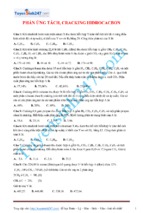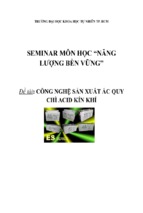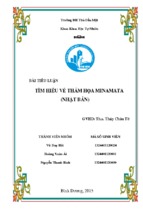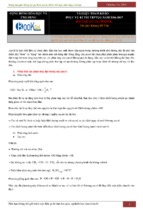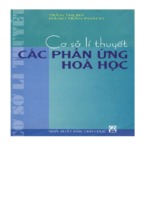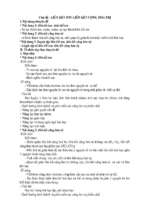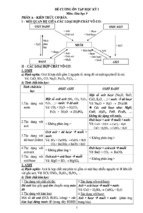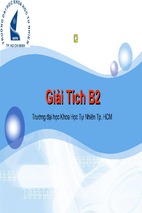This page
intentionally left
blank
Copyright © 2004, New Age International (P) Ltd., Publishers
Published by New Age International (P) Ltd., Publishers
All rights reserved.
No part of this ebook may be reproduced in any form, by photostat, microfilm,
xerography, or any other means, or incorporated into any information retrieval
system, electronic or mechanical, without the written permission of the publisher.
All inquiries should be emailed to
[email protected]
ISBN (13) : 978-81-224-2553-6
PUBLISHING FOR ONE WORLD
NEW AGE INTERNATIONAL (P) LIMITED, PUBLISHERS
4835/24, Ansari Road, Daryaganj, New Delhi - 110002
Visit us at www.newagepublishers.com
This page
intentionally left
blank
PREFACE
The ‘art and skill’ for the preparation of ‘newer drug molecules’ is a pivotal creative and an
exceptionally great intellectual exercise that essentially serves as a fulcrum to plethora of specific areas of scientific research, ranging from the most applied to the most academic. Accordingly, the medicinal chemist, organic chemist, biologist, pharmacologist, biochemist,
biotechnologist, phytochemist, genetic engineer, materials scientist, and polymer scientist, in
an university or an industry, all must have genuinely encountered with the most challenging
and intricate task of performing a reaction ultimately leading to an entirely new organic preparation exhibiting certain specific actions on the biological system to combat diseases in the
ailing human beings.
Invariably, the wonderful ‘magic’ of modern organic synthesis, based on host of documented theories, hypothesis, organic name reactions (ONRs) amalgamated with logistic, scientific and assertive reaction mechanism(s), in fact, genuinely paved the way of complicated, notso-easy, cumbersome course of reactions much simpler and understandable.
The advent of ever-more sophisticated and many supportive modern analytical techniques, such as : UV, IR, NMR, MS, ORD, CD, AAS, FES, GC, HPLC and the hyphenated
techniques as well, have tremendously enhanced the confidence of medicinal chemists to such a
magnitude as to maximize both the chances of success rate and probability factor.
Besides, the use of organic and inorganic chemicals employed as reactants, catalysts,
medium of reaction, purifying substances etc., are not only harmful but also hazardous in nature. Nevertheless, the various conditionalities of critical and specific reactions are sometimes
articulated and spelled out so meticulously that one has to follow them just like ‘gospel truth’,
to accomplish the right synthesis, and hence, the right product.
It is, however, pertinent to mention here that the UG and PG students, associated with
the myth and reality of ‘drug synthesis’ should make an honest attempt to carry out a particular synthesis of a drug substance with a most tried and tested methodical, scientific and rational approach, so that one may get reproducible results under a particular reaction in a seamless manner.
The copious volumes of textbooks, scientific research journals, monographs, review articles on related topics like : organic chemistry of drug synthesis, chiral chemistry, drug design,
principles of medicinal chemistry, organic medicinal and pharmaceutical chemistry, and medicinal chemistry provide ample evidence and scope to suggest that the comprehensive in-depth
knowledge together with utmost specialized state-of-the-art know-how of the various techniques
is an absolute necessity and basic requirement to have a real understanding with regard to the
practical aspects of ‘Medicinal Chemistry’.
In ‘Advanced Practical Medicinal Chemistry’, an attempt has been made to stress
the much needed requirement of both undergraduate and graduate students specializing in the
field of Pharmaceutical Chemistry to learn how to synthesize ‘drugs’ in the laboratory. Unfortunately, the common available textbooks ordinarily referred to by the Pharmacy Students
( viii )
mostly deal with the synthesis of pure ‘organic compounds’ ; and hence, do not provide the
real and much needed subject matter relevant to a budding ‘Medicinal Chemist’.
The ‘Advanced Practical Medicinal Chemistry’ comprises of four major chapters
that are intimately associated with specific emphasis on the synthesis of a broad range of some
typical and selected ‘drugs’ commonly found in the therapeutic armamentarium.
Chapter-1 deals with ‘Safety in a Chemical Laboratory‘. It consists of various aspects,
namely : guard against personal safety ; conduct in a chemistry laboratory ; neatness and cleanliness ; after-hours working ; guidelines for accident or injury ; storage of chemicals/reagents in
a chemical laboratory ; glass ware ; waste disposal ; an ideal chemistry laboratory ; and toxicity
and hazards of chemicals/reagents.
Chapter-2 consists of ‘Drug Synthesis’. First, aspect being—‘Conceptualization of a Synthesis‘ viz., prime considerations in designing synthesis ; the Synthon Approach ; reaction
specificity. Secondly, Reaction Variants, viz., structural variants ; interchangeability of functional moiety ; selectivity in reactions ; protection of functional moieties ; elimination of functional moieties ; annealation reactions ; fragmentation reactions. Thirdly, Stereochemistry, viz.,
nucleophilic substitutions (SN2), ionic additions to C-C double bonds ; catalytic hydrogenation ;
acid or base promoted enolization of compounds, reductions of cyclohexane ; and cycloadditions.
Chapter-3 comprises of ‘Performing the Reactions’. The wide range of latest laboratory
techniques invariably employed in a reasonably well equipped chemical research laboratory or
a chemical laboratory for actually performing the specifically desired reactions and other equally
important operational measures have been dealt with in an explicit and lucid manner. The
various aspects included in this chapter are, namely : solvent stills (with continuous still collecting head)-reactions performed at elevated temperatures-large scale reaction and slow addition of reagents-low temperature reactions-reaction above room temperature using a condensermechanical stirrer-mechanical shaker-crystallization at low temperature-distillation under reduced pressure-small scale distillation-performing the reaction, and -photolysis.
Chapter-4 i.e., the last chapter, has been exclusively devoted to—‘Synthesis of Medicinal Compounds’ which vary in length from the single-stage reaction to the multi-stage or projecttype synthesis. In fact, it is the backbone of the present textbook and specially designed to
inculcate the sense of creativity, learning the art of synthesis, and above all inject the spirit of
zeal and enthusiasm amongst the ‘medicinal chemists’ to tackle most synthesis-related problems with great ease, confidence and fervour. It embraces ‘three’ specific areas of interest
confined to the ‘synthesis of drugs’, such as :
(a) Types of Chemical Reactions e.g., acetylation methods-benzoylation methodssulphonation methods-bromination methods-condensation reactions ; and diazotization and
coupling reactions ;
(b) Organic Name Reactions (ONRs) e.g., Bart reaction-Diel’s-Alder reaction-FriedelCraft’s reaction-Fries reaction-Grignard reaction-Hoesch reaction-Perkin reaction-Mannich
reaction-Michael reaction, and Reimer-Tieman reaction ;
(c) Selected Medicinal Compounds : It includes the synthesis of forty selected medicinal
compounds having a wide variety of therapeutic action(s).
An intensive and extensive care has been exercised painstakingly and meticulously to
discuss in details each and every medicinal compound under the above mentioned three categories i.e., (a) through (c) in a particular original style of presentation that essentially includes :
( ix )
chemical structure-synonym(s)/chemical name(s)-theory-chemicals required-procedure-precautions-recrystallization-theoretical yield/practical yield-physical parameters-uses, and -questions
for viva-voce.
A subtle, but no less profound effect of this completely new approach as given in the
‘Advanced Practical Medicinal Chemistry’ comprising of syntheses totalling eighty selected ‘drug substances’ would not only benefit the undergraduate and graduate students in
Pharmaceutical Chemistry in Indian Universities and other developing countries as well, but
also go a along way to help the esteemed teachers involved in the handling of such courses who
always genuinely felt the dire necessity of such a compilation for the ‘academics’ in particular.
The ‘medicinal chemists’ involved in ‘Bulk Drug Manufacturing Operations’ may also
find this presentation as a handy reference book in the domain of their ever expanding and
demanding profession.
In case, the above outlined objectives have been duly achieved, actual users of this textbook must be able to accomplish their synthetic problems with greater ease and confidence.
Synthesis of ‘Medicinal Compounds’ is not only satisfying but also exciting, and provides an
ample opportunity to explore an individual’s inherent talent and enormous strength of ‘real
creativities’.
Ashutosh Kar
This page
intentionally left
blank
( xi )
CONTENTS
Preface (vii)
1.
SAFETY IN A CHEMISTRY LABORATORY 1
1.1.
1.2.
2.
Introduction 1
Guard Against Personal Safety 2
1.2.1. Protective Coat 2
1.2.2. Protection for Eyes 2
1.2.3. Conduct in a Chemistry Laboratory 3
1.2.4. Neatness and Cleanliness 3
1.2.5. After-Hours Working 6
1.2.6. Guidelines for Accident or Injury 6
1.2.7. Storage of Chemicals/Reagents in a Chemical Laboratory 7
1.2.8. Glassware 8
1.2.9. Waste Disposal 9
1.2.10. An Ideal Chemistry Laboratory 9
1.2.11. Toxicity and Hazards of Chemicals Reagents 10
DRUG SYNTHESIS
2.1.
2.2.
2.3.
2.4.
2.5.
Introduction 15
Conceptualization of a Synthesis 15
2.2.1. Prime Considerations in Designing Synthesis 16
2.2.2. The Synthon Approach 17
2.2.3. The Retro-Synthetic Approach 18
2.2.4. Materials Required 19
2.2.5. Reaction Specificity 20
2.2.6. Purity and Yield 21
Reaction Variants 21
2.3.1. Structural Variants 21
2.3.2. Interchangeability of Functional Moiety 22
2.3.3. Selectivity in Reactions 27
2.3.4. Protection of Functional Moieties 28
2.3.5. Elimination of Functional Moieties 31
2.3.6. Annelation Reactions 32
2.3.7. Fragmentation Reactions 34
Stereochemistry 37
2.4.1. The Chiral Centre 37
Summary 43
C-8—N-ADV\TITLE.pm5 xi
( xii )
3.
PERFORMING THE REACTIONS 45
3.1.
4.
Introduction 45
I.
Solvent Stills 46
II.
Reactions Performed at Elevated Temperatures 49
III.
Large Scale Reactions and Slow Addition of Reagents 50
IV.
Low Temperature Reactions 50
V.
Reactions above Room Temperature Using a Condenser 54
VI.
Mechanical Stirrers 56
VII.
Mechanical Shakers 57
VIII.
Sonication 58
IX.
Crystallization at Low Temperature 59
X.
Distillation Under Reduced Pressure 60
XI.
Small Scale Distillation 62
XII.
Performing the Reaction 62
XIII.
Photolysis 64
SYNTHESIS OF MEDICINAL COMPOUNDS 67
4.1.
4.2.
4.3.
4.4.
Acetylation Methods 67
4.1.1. Introduction 67
4.1.2. Synthesis of Medicinal Compounds 71
4.1.2.1. Acetanilide 71
4.1.2.2. Aspririn 75
4.1.2.3. Acetylacetone 80
4.1.2.4. Phenacetein 83
4.1.2.5. Acetylcysteine 86
4.1.2.6. Paracetamol 88
Benzoylation Methods 90
4.2.1. Introduction 90
4.2.2. Synthesis of Medicinal Compounds 93
4.2.2.1. Benzoyl Glycine 93
4.2.2.2. N-Benzoyl-beta-alanine 95
4.2.2.3. Flavone 97
4.2.2.4. Benzoyl Peroxide 100
4.2.2.5. Benzoyl Benzoate 103
Sulphonylation Methods 105
4.3.1. Introduction 105
4.3.1.1. Similarity with Benzoylation 106
4.3.1.2. Dissimilarity with Benzoylation 106
4.3.2. Synthesis of Medicinal Compounds 107
4.3.2.1. Dichloramine-T 108
4.3.2.2. Chloramine-T 112
Bromination Methods 115
4.4.1. Introduction 115
4.4.1.1. Mechanism of Bromination 115
C-8—N-ADV\TITLE.pm5
xii
( xiii )
4.4.2.
4.5.
4.6.
4.7.
4.8.
Synthesis of Medicinal Compounds 116
4.4.2.1. para-Bromoacetanilide 116
4.4.2.2. para-Bromophenol 118
4.4.2.3. 2′, 4′, 5′, 7′-Tetrabromofluorescein 121
Condensation Reactions 125
4.5.1. Claisen Condensation 125
4.5.2. Sorbic Acid 128
4.5.3. Pechman Condensation 130
Diazotization and Coupling Reactions 133
4.6.1. Phenyl-azo-beta-naphthol 136
4.6.2. 5-Diazouracil 139
4.6.3. Dimethyl-p-phenylenediamine 140
Organic Name Reactions (ONRs) 145
4.7.1. Bart Reaction 145
4.7.1.1. Phenylarsonic Acid 146
4.7.2. Diels-Alder Reaction 149
4.7.2.1. 9, 10-Dihydroanthracene-9, 10-endo-αβ-succinic anhydride 150
4.7.3. Friedal-Craft’s Reaction 150
4.7.3.1. Acetophenone 153
4.7.3.2. p-Methylacetophenone 158
4.7.3.3. Anthrone 160
4.7.4. Frie’s Reaction 165
4.7.4.1. p-Hydroxypropiophenone 166
4.7.5. Grignard Reaction 168
4.7.5.1. Benzoic acid 169
4.7.5.2. Triphenylcarbinol 172
4.7.6. Hoesch Reaction (or Houben-Hoesch Reaction) 175
4.7.6.1. Floropione 176
4.7.6.2. Resacetophenone 179
4.7.7. Perkin Reaction 181
4.7.7.1. Cinnamic acid 182
4.7.7.2. Coumarin 185
4.7.8. Mannich Reaction 187
4.7.8.1. Metamfepramone 188
4.7.8.2. Garmine 190
4.7.9. Michael Reaction 192
4.7.9.1. 5, 5-Dimethyl-1, 3-cyclohexanedione 193
4.7.9.2. Tricarballylic Acid 195
4.7.10. Reiner-Tiemann Reaction 200
4.7.10.1. para-Anisaldehyde 201
4.7.10.2. Salicylaldehyde 203
Selected Medicinal Compounds 206
4.8.1. Acyclovir 207
4.8.2. Acetaminophen 209
C-8—N-ADV\TITLE.pm5
xiii
( xiv )
4.8.3.
4.8.4.
4.8.5.
4.8.6.
4.8.7.
4.8.8.
4.8.9.
4.8.10.
4.8.11.
4.8.12.
4.8.13.
4.8.14.
4.8.15.
4.8.16.
4.8.17.
4.8.18.
4.8.19.
4.8.20.
4.8.21.
4.8.22.
4.8.23.
4.8.24.
4.8.25.
4.8.26.
4.8.27.
4.8.28.
4.8.29.
4.8.30.
4.8.31.
4.8.32.
4.8.33.
4.8.34.
4.8.35.
4.8.36.
4.8.37.
4.8.38.
4.8.39.
4.8.40.
Busulfan 211
Buthiazide 213
Benzocaine 216
Coumarin-3-carboxylic acid 221
Chlormezanone 226
Chlorpropamide 229
Clotrimazole 231
Diazoxide 233
Diclofenac Sodium 236
5, 5-Diphenyl Hydantoin (Phenytoin) Sodium 239
Ethamivan 242
Etofylline Clofibrate 243
Fenbufen 246
Flumethiazide 248
Guaifensin 250
Guanethidine Sulphate 252
Haloprogin 255
Hepronicate 257
Indomethacin 259
Isocarboxazid 262
Isoniazid 264
Ketotifen 266
Loxapine 269
Mazindol 272
Methyldopa 275
Metronidazole 277
Naproxen 279
Niclosamide 281
Oxaceprol 283
Oxyfedrine 285
Phensuximide 286
Povidone Iodine 288
Ritodrine 290
Simethicone 292
Ticrynafen 294
Tocainide 298
Trimethoprim 300
Zipeprol 304
Index 307
C-8—N-ADV\TITLE.pm5
xiv
CHAPTER 1
Safety in a Chemistry Laboratory
1.1 INTRODUCTION
A well-designed, well-equipped and strategically located chemical laboratory is really a
wonderful place for a research chemist where one may transform one’s conceptualized theoretical
novel ideas into sharply evident reality in the shape of useful ‘target-drug-molecule’. The
on-going quest for newer drugs is an eternal endeavour across the globe to improve the quality
of life of human beings irrespective of their caste and creed.
Nevertheless, a chemistry laboratory should not be regarded as a ‘dangerous place’ to
carry out planned experimental procedures, in spite of the several potential hazards that may
be directly or indirectly associated with them, provided that one strictly observes and maintains
certain basic fundamental important precautions amalgamated with unusual alertness,
extraordinary presence of mind and superb common sense.
It is, of course, an usual practice to have a chemical laboratory directly under the
command and supervision of a senior cadre laboratory technical personnel who should be
consulted, as and when required, for his expert opinion and advice. It is, however, pertinent to
mention here that two vital universal truths and norms, namely : first, exercise of utmost
care ; and secondly, adoption of strict safe-working procedures, should be the prime
responsibility of each and every individual working in a chemistry laboratory. No compromise,
whatsoever, must be made with regard to even an iota of doubt as to the safety of a proposed
experimental procedure yet to be undertaken. Liberal consultation, advice from senior research
personnels, academic supervisors should be sought freely and frankly without the slightest
hesitation in one’s mind.
Genuinely speaking, everybody should not only adopt but also execute an extremely
high sense of responsible attitude towards their work. There is absolutely no scope of any sort
of hurried behaviour, short-cut procedures, thoughtless or ignorant line-of-action that may
end-up with an accident and most probable harm caused to themselves and others too. They
must be fully aware of what is going on elsewhere or around them in the same laboratory setup ; and be fully conversant of the possible hazards taking place either ensuing from their own
experiments or arising from others.
It has been observed beyond any reasonable doubt that most of the unfortunate accidents
in a chemical laboratory invariably occurs on account of such glaring facts, namely : to achieve
results in the quickest possible time-frame, to ignore knowingly certain already familiar and
1
P-IV\C:\N-ADV\CH1-1
2
ADVANCED PRACTICAL MEDICINAL CHEMISTRY
prohibited short-cut method(s), and lastly to work half-heartedly and carelessly in a laboratory.
Therefore, one must abide by the Golden Rules to maintain and create the safest environment
in a chemical laboratory, such as : to work carefully, methodically, painstakingly, thoughtfully,
diligently and above all whole-heartedly.
In short, it may be summarized that an unplanned event causing damage or injury to
oneself, otherwise termed as an ‘accident’, in a chemical laboratory can be avoided to a bearminimum-level, if not cent-per-cent, by adopting all safety norms and procedures besides working with a ‘cool mind’ and a ‘smile’ on the face.
1.2 GUARD AGAINST PERSONAL SAFETY
A ‘research chemist’ must ensure that he/she is not subjected to any sort of risk or danger
against his/her personal safety, at any cost, while working in a chemical laboratory.
1.2.1 Protective Coat
Each and every person working in a chemical laboratory should put on a full-length and fullsleeve protective coat, preferably white, because any type of stains and inadvertent spillages
are more apparently visible and detected vividly.
1.2.2 Protection for Eyes
The human eye is probably the most vital sense-organ, and obviously the most delicate due to
its fragility. Therefore, the protection for eyes is of top-priority with regard to several possible
eye-hazards, namely : exposure to the dust of fine chemicals, fumes or vapours, sudden splashing
of liquid chemicals (hot or cold) and even from splinters of glass wares that get exploded while
performing an experiment. In order to avoid such untoward and unpredictable possible hazards
in a chemical laboratory the use of a pair of safety glasses should be mandatory. There are a
plethora of superb quality, pretested, certified, light-weight spectacles and goggles abundantly
available from various reputed laboratory suppliers. These eye protective guards do provide in
routine use the necessary required good coverage of the eyes and also the upper face. Of course,
there are several models and designs that are quite suitable for use upon the prescription
glasses.
Nevertheless, prescription safety glasses, that are made-to-order, are readily available
through specialized sources only, and though a little more expensive, should be used exclusively
for the full-time laboratory researcher or staff. It has been observed that the contact lenses do
provide certain extent of protection against possible mechanical damage to the eye ; however,
the wearing of protective goggles is still very much essential and almost a must.
It is pertinent to mention here that either the usage of close-fitting-safety spectacles
or, preferably, a vison covering the entire face may provide a much enhanced level of
protection in the event of chemical splashing or spraying of corrosive or toxic hot liquids or
gases.
Importantly, while carrying out experiments that are either suspected to be explosive or
hazardous in nature, additional protection afforded by safety-screens is vehemently
recommended.
P-IV\C:\N-ADV\CH1-1
SAFETY IN A CHEMISTRY LABORATORY
3
Fume-Cupboards. All experiments involving toxic solvents and reagents should be
carried out in an efficient fume-cupboard provided with a heavy-duty chemical protected exhaust system.
Disposable Plastic Gloves. Good quality disposable plastic gloves must be used profusely while handling both corrosive and poisonous chemicals.
1.2.3 Conduct in a Chemistry Laboratory
The overall conduct in a ‘chemical laboratory’ should be associated with dignity, discipline,
maturity, poised behaviour, cool temperament, charged with excellent presence of mind and
above all a soft-spoken pleasant disposition. It is, however, absolutely necessary to invoke a
high degree of self-discipline with regard to the following cardinal aspects, namely :
• Over-hurried activity
• Smoking
• Eating and drinking
• Irresponsible behaviour (or practical jokes)
• Shouting and screaming.
Over-hurried activity particularly in a chemical laboratory may tantamount to serious mishaps thereby causing both intensive and extensive damage/injury to oneself, others
and also the laboratory as such.
Smoking is strictly prohibited in a chemical laboratory for obvious reasons that invariably the organic solvent or their fumes are highly inflammable.
Eating and drinking in a chemical laboratory should be forbidden so as to avoid the
possible risk of ingestion of toxic substances either directly or indirectly.
Irresponsible behaviour (or practical jokes) must not be allowed while working in a chemical laboratory so as to maintain both santity and a congeneal atmosphere amongst the colleagues of either sex.
Shouting and screaming may be avoided, as far as possible to distract someone’s
concentration or attention unduly that may perhaps cause personal distress or pain totally
uncalled for.
1.2.4 Neatness and Cleanliness
It is a well-known common addage that—‘next to godliness is cleanliness’. A chemical laboratory
must maintain a high degree of neatness and cleanliness that may indirectly contribute as a
major factor in laboratory safety. Passageways either around the working benches or in-between
them should not be made untidy by litter rather these are to be thrown into a metallic-covereddustbin kept in one corner of the laboratory. The top of the working bench always be kept neat
and tidy and avoid scattering with apparatus not-in-use. All such apparatus should be stored
in the cup-board beneath the bench. Likewise, all dirty apparatus should be dipped in either a
solution of a detergent or a cleansing-mixture in a plastic bowl a little away from the working
area that may be cleaned and kept away for future usage as and when required.
Note. All solid and filter paper waste should not be thrown in the sink.
P-IV\C:\N-ADV\CH1-1
4
ADVANCED PRACTICAL MEDICINAL CHEMISTRY
It is the prime responsibility of a ‘good chemist’ to meticulously and scrupulously clean
and subsequently drying of all used glasswares. For highly moisture-sensitive compounds the
glasswares need to be rinsed with acetone, twice at least, dried in an oven and brought to
ambient temperature in a desicator. It is indeed advisable to clean-up the used reaction flasks
and other apparatus immediately after their usage so as to avoid tedious cleansing process
later on.
It is pertinent to mention here that there exists not a single known universal cleansing
mixture. Therefore, based on the nature of the deposit and amount of the deposit a chemist
must undertake the process of cleaning accordingly in a systematic manner rather than adopting
a haphazard style.
The various usual standard cleansing processes are stated below in a sequential manner ; namely :
(1) For basic residues. Dilute sulphuric acid or hydrochloric acid may dissolve the basic
residues completely.
(2) For acidic residues. Dilute sodium hydroxide solution is probably the commonest and
the best cleansing agent for most acidic residues.
Note : In (1) and (2) above cases the washings of basic and acidic aqueous solutions may be washed
down the drain thoroughly with plenty of fresh water so that the drainage pipes are duly flushed
out of the corrosive substances.
(3) For organic solvent miscible residues. In instances where the stubborn residues that
are miscible only in comparatively cheaper solvents, may be used profusely and should
be collected in the ‘residues’ bottle and not down the sink. The combined residual
organic solvent may be distilled off to recover the ‘good’ solvent and reject the heavily
contaminated material appropriately.
(4) Fro gross deposits. The cheapest, best, and simplest means to get rid of gross deposits
may be accomplished by employing commercial household washing powder containing
an abrassive component that does not necessarily scratch the glass surfaces at all,
such as : ‘Rin’, ‘Vim’, ‘Ajax’ etc,. The washing powder could be applied either directly
into the apparatus previously moistened with water or using a test-tube cleaning
brush that has been soaked into the powder ; the surface of the glass is subsequently
scrubbed gently followed by vigorously until the sticking dirst has been removed
entirely. Ultimately, the glass apparatus is washed and rinsed thoroughly with ‘soft’
tapwater.
Note : In the event when washing with a mixture of washing powder and water fails to give an entirely
satisfactory results, the powder may be mixed with a polar organic solvent, for instance : acetone
or iso-propanol.
Importantly, in case the above cited four cleansing methods do not offer hundred per
cent satisfaction one may attempt any one of the following three vigorous and stringent
‘alternative’ cleansing solutions, namely :
(a) Trisodium Phosphate Solution [Na3 PO4 ; 15% (w/v)]. A warm (30-40°C) solution
of trisodium phosphate which has been mixed with a small quantum of an abrassive
powder e.g., pumice powder. However, this particular reagent is not suitable for the
cleansing of either tarry residues or sticky/gummy materials.
P-IV\C:\N-ADV\CH1-1
5
SAFETY IN A CHEMISTRY LABORATORY
(b) Decon 90. It is an extremely effective surface-active-agent, which is asserted to be
practically able to take care of all laboratory cleansing operations. Besides, it also
bears other remarkable characteristic features of the present day consumer
acceptability requirements, namely : 100% biodegradable, almost non-toxic,
phosphate-free, and totally rinsable. It has been widely recommended for the removal
of various obstinate deposits, such as : tars, polymeric residues, greases and silicone
oils.
(c) ‘Chromic Acid’ Cleaning Mixture. It is considered to be one of the commonest,
tried and tested cleansing mixture most abundantly employed in practically all
chemical laboratories across the globe.
Preparation. The ‘chromic-acid’ cleansing mixture may be prepared conveniently from
the following ingredients :
(i) Sodium dichromate
(ii) Water
:5g
: 5 ml
(iii) Sulphuric acid (36 N) : 100 ml.
First of all, 5 g of sodium dichromate are dissolved in 5 ml of water in a 250 ml pyrex
glass beaker to which 100 ml of concentrated sulphuric acid are added in small lots at intervals
with frequent stirring with a clean glass rod. Being an exothermic reaction the temperature
will rise to 70–80°C initially, which may be allowed to fall down to 40°C over a span of time.
The cooled cleansing mixture may be transferred to a clean, dry and labelled glass-stoppered
bottle.
The glass apparatus to be cleaned must be rinsed with water to get rid of the watersoluble organic matter as far as possible along with the possible reducing agents, if any.
Subsequently, the water is drained off from the apparatus to its maximum extent ; and the
‘chromic acid’ cleaning mixture is introduced into it in a quantity just sufficient to smear the
solid residue adequately, while the main quantum of the cleaning mixture returned to the
stock bottle. The cleaning mixture treated apparatus is allowed to stand for about 15–20 minutes,
with occasional swirling of the apparatus to stretch out the liquid onto the surface of the solid
residue, the former is rinsed thoroughly with running tap water an finally with distilled water.
Note : It is advisable not to attempt any other ‘chemical treatment’ whatsoever due to the possible
ensuing explosion hazards.
Ultrasonic* Bath. The use of ultrasonic energy to clean objects, including medical
and surgical instruments is a very common practice in a hospital environment.
Importantly, such sophisticated techniques have also been exploited from a highly sensitive sterile-zone of an ‘operation theatre’ in a hospital to the ‘chemical laboratory’ for
the benefit of ‘research chemists’ as well.
The ultimate and final removal of ‘trace residues’ from previously treated and cleaned
glass apparatus may be accomplished by ultrasonic bath having various capacities ranging
from 2.7 to 85 litres, and the tank fluid in Decon 90.
*Ultrasonic. Pertaining to sounds of frequencies above approximately 20,000 cycles per second, which
are inaudible to the human ear.
P-IV\C:\N-ADV\CH1-1

